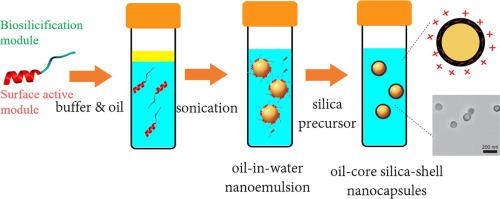Journal of Colloid and Interface Science ( IF 9.4 ) Pub Date : 2020-07-26 , DOI: 10.1016/j.jcis.2020.07.107 Tengjisi 1 , Yue Hui 1 , Guangze Yang 1 , Changkui Fu 1 , Yun Liu 1 , Chun-Xia Zhao 1

|
Biomimetic nanomaterials have attracted tremendous research interest in the past decade. We recently developed biomimetic core–shell nanoparticles – silica nanocapsules, using a designer dual-functional peptide SurSi under room temperature, neutral pH and without use of any toxic reagents or chemicals. The SurSi peptide is designed capable of not only stabilizing nanoemulsions because of its excellent surface activity, but also inducing the formation of silica through biosilicification at an oil–water interface. However, it remains challenging to precisely control the peptide-induced nucleation and biosilicification specifically at the oil–water interface, thus forming oil-core silica-shell nanocapsules with uniform size and monodispersity. In this study, the fundamental mechanism of silica formation through a peptide catalyzed biosilicification was systematically investigated, so that the formation of oil-core silica-shell nanocapsules can be precisely controlled. The SurSi peptide induced hydrolysis and nucleation of biomineralized silica particles were monitored to study the biosilicification kinetics. Effects of pH, SurSi peptide concentration and pre-hydrolysis of silica precursors were also studied to optimize the formation of biomimetic silica nanocapsules. The fundamental understanding achieved through these systematic studies provides valuable insights for making core–shell nanoparticles via controlling nucleation and reaction at interfaces.
中文翻译:

使用双功能肽的仿生核壳二氧化硅纳米粒子。
在过去的十年中,仿生纳米材料引起了巨大的研究兴趣。我们最近在室温,中性pH且不使用任何有毒试剂或化学药品的情况下,使用设计者的双功能肽SurSi开发了仿生核-壳纳米颗粒-二氧化硅纳米胶囊。SurSi肽由于其出色的表面活性而被设计为不仅能够稳定纳米乳剂,而且还可以通过油水界面的生物硅化作用诱导二氧化硅的形成。然而,精确地控制肽诱导的成核作用和生物硅化作用(特别是在油-水界面处),从而形成具有均一大小和单分散性的油核硅壳纳米胶囊仍然具有挑战性。在这个研究中,系统地研究了通过肽催化的生物硅化作用形成二氧化硅的基本机理,从而可以精确地控制油核二氧化硅壳纳米胶囊的形成。监测SurSi肽诱导的生物矿化二氧化硅颗粒的水解和成核,以研究生物硅化动力学。还研究了pH,SurSi肽浓度和二氧化硅前体的预水解的影响,以优化仿生二氧化硅纳米胶囊的形成。通过这些系统研究获得的基本理解为通过控制界面处的成核作用和反应为制造核壳纳米粒子提供了宝贵的见识。监测SurSi肽诱导的生物矿化二氧化硅颗粒的水解和成核,以研究生物硅化动力学。还研究了pH,SurSi肽浓度和二氧化硅前体的预水解的影响,以优化仿生二氧化硅纳米胶囊的形成。通过这些系统研究获得的基本理解为通过控制界面处的成核作用和反应为制造核壳纳米粒子提供了宝贵的见识。监测SurSi肽诱导的生物矿化二氧化硅颗粒的水解和成核,以研究生物硅化动力学。还研究了pH,SurSi肽浓度和二氧化硅前体的预水解的影响,以优化仿生二氧化硅纳米胶囊的形成。通过这些系统研究获得的基本理解为通过控制界面处的成核作用和反应为制造核壳纳米粒子提供了宝贵的见识。











































 京公网安备 11010802027423号
京公网安备 11010802027423号